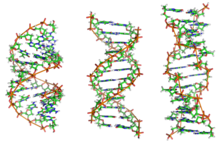Lesch–Nyhan syndrome (LNS), also known as Nyhan's syndrome, Kelley-Seegmiller syndrome and Juvenile gout[1]:546, is a rareinherited disorder caused by a deficiency of the enzyme hypoxanthine-guanine phosphoribosyltransferase (HGPRT), produced bymutations in the HPRT gene located on (the) X chromosome. LNS affects about one in 380,000 live births.[2] The disorder was first recognized and clinically characterized by medical student Michael Lesch and his mentor, pediatrician Bill Nyhan, who published their findings in 1964.[3]
The HGPRT deficiency causes a build-up of uric acid in all body fluids. This results in both hyperuricemia and hyperuricosuria, associated with severe gout and kidney problems. Neurological signs include poor muscle control and moderate mental retardation. These complications usually appear in the first year of life. Beginning in the second year of life, a particularly striking feature of LNS is self-mutilating behaviors, characterized by lip and finger biting. Neurological symptoms include facial grimacing, involuntary writhing, and repetitive movements of the arms and legs similar to those seen in Huntington's disease. The direct cause of the neurological abnormalities remains unknown. Because a lack of HGPRT causes the body to poorly utilize vitamin B12, some boys may developmegaloblastic anemia.[4
羧端 carboxyl terninal
Trypsin (EC 3.4.21.4) is a serine protease found in the digestive system of many vertebrates, where it hydrolyses proteins.[2][3] Trypsin is produced in the pancreas as the inactive proenzyme trypsinogen. Trypsin cleaves peptide chains mainly at the carboxyl side of theamino acids lysine or arginine, except when either is followed by proline.
35 胰蛋白酶(trypsin)切於蛋白質內何種胺基酸之羧端?
苯丙胺酸(phenylalanine) 離胺酸(lysine)
甲硫胺酸(methionine) 天冬胺酸(aspartate)
ans lysine

- Collagen One: skin, tendon, vascular ligature, organs, bone (main component of bone)
- Collagen Two: cartilage (main component of cartilage)
- Collagen Three: reticulate (main component of reticular fibers), commonly found alongside type I.
- Collagen Four: forms bases of cell basement membrane
- Collagen Five: cells surfaces, hair and placenta
Collagen has an unusual amino acid composition and sequence:
- Glycine (Gly) is found at almost every third residue
- Proline (Pro) makes up about 17% of collagen
- Collagen contains two uncommon derivative amino acids not directly inserted during translation. These amino acids are found at specific locations relative to glycine and are modified post-translationally by different enzymes, both of which require vitamin C as a cofactor.
- Hydroxyproline (Hyp), derived from proline.
- Hydroxylysine (Hyl), derived from lysine (Lys). Depending on the type of collagen, varying numbers of hydroxylysines are glycosylated(mostly having disaccharides attached).
Cortisol stimulates degradation of (skin) collagen into amino acids.[30
43 下表為三種不同雙螺旋DNA 結構(A form; B form; Z form)的特性,請指出代號W、X、Y 的結構型
式(structural form)名稱:
型式 雙螺旋的轉向每一螺旋上的鹼基數每個鹼基的間距
W 左旋 12個鹼基 0.37 nm
X 右旋 11個鹼基 0.255 nm
Y 右旋 10個鹼基 0.34 nm
W = Z form DNA; X = A form DNA; Y = B form DNA
W = Z form DNA; X = B form DNA; Y = A form DNA
W = A form DNA; X = Z form DNA; Y = B form DNA
W = A form DNA; X = B form DNA; Y = Z form DNA
http://en.wikipedia.org/wiki/A-DNA
Comparison Geometries of the Most Common DNA Forms
| Geometry attribute: | A-form | B-form | Z-form |
|---|---|---|---|
| Helix sense | right-handed | right-handed | left-handed |
| Repeating unit | 1 bp | 1 bp | 2 bp |
| Rotation/bp | 33.6° | 35.9° | 60°/2 |
| Mean bp/turn | 11 | 10.5 | 12 |
| Inclination of bp to axis | +19° | −1.2° | −9° |
| Rise/bp along axis | 2.4 Å (0.24 nm) | 3.4 Å (0.34 nm) | 3.7 Å (0.37 nm) |
| Rise/turn of helix | 24.6 Å (2.46 nm) | 33.2 Å (3.32 nm) | 45.6 Å (4.56 nm) |
| Mean propeller twist | +18° | +16° | 0° |
| Glycosyl angle | anti | anti | pyrimidine: anti, purine: syn |
| Sugar pucker | C3'-endo | C2'-endo | C: C2'-endo, G: C2'-exo |
| Diameter | 26 Å (2.6 nm) | 20 Å (2.0 nm) | 18 Å (1.8 nm) |


No comments:
Post a Comment